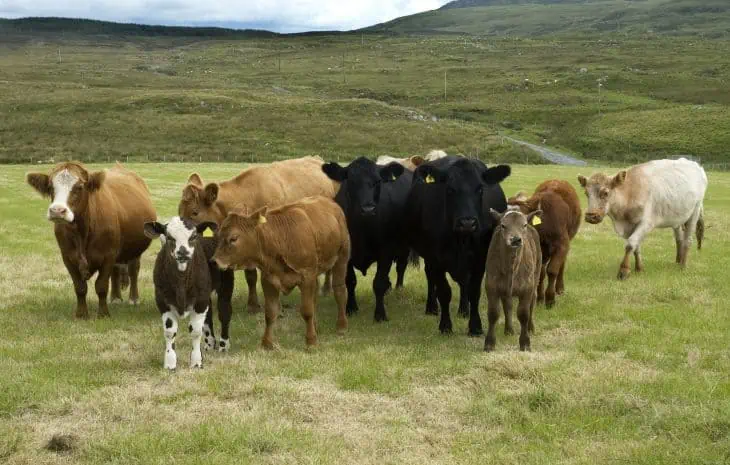
Have you ever wondered how many types of cows and bulls there are? There are over 250 recognized breeds of cows, and there are more than 70 breeds of American cattle alone. Despite this, only an average number of people actually know more about cattle. This article covers all you need to know about the three types of cattle: dairy, beef, and draught.
There are different classes and uses for cattle, and each of them is split into three major groups. The first group is the dairy cattle, which can be milk cow breeds. The second one is the beef cattle, raised to be turned into meat products (such as the Texas Longhorns.) Finally, the draught cattle comes last, which has a similar function to the draught horse’s class. While it can be said that one cow or bull may fit into two categories, or even all of them, they are still placed into the class they are most often used.
It’s important to know all types of cows with different colors, such as red cows, brown cows, and even oreo cows. Cattle are an abundant source of products, since milk is an important ingredient for strong bones, along with beef that provides good protein, and finally, leather goods made from their hides. Therefore, we should know more about these wonderful animals to appreciate the products they give us. Here are ten examples of each class of cattle for you to learn more about.
Origin of Cattle
There are a lot of types of cows that circulate the globe, but all of them are descendants of aurochs. The aurochs were native to the subcontinent of India and spread throughout China and the Middle East. There came a time when they finally managed to reach Europe and Northern Africa. And just like the caribou and the reindeer, aurochs were wild cattle that were never domesticated. Unfortunately, they have now become extinct. The last auroch sighting dates back to 1627 in Poland.
There are two scientific names for cattle: Bos Taurus and Bos Indicus. The main difference between the two is that cattle that fall into the Bos Taurus are mainly of European descent. The Bos Indicus group is mostly considered Indian. It makes sense, as their origins are from India. An interesting fact about male cattle (bulls) is that they aren’t that enraged by the color red, rather, they are more irritated by the movement of the color red than the matadors do.
Cattle vs Cow vs Bull
Many people mistake the word “cow” for “cattle” and justifiably so. Cattle is the correct term referring to both males and females of the Bos Taurus (European descent) and Bos Indicus (Brahman descent.) On the other hand, most people call them cows to refer to the whole breed. However, the word cow is actually referring to only female versions of a specific breed of cattle. Hence, the term “female cow” is actually not the correct term. The right term for its male counterpart is the bull. Animal or not, the bull is a popularly known term. It could be used for the term “bullish” in investments, or in bullfights.
Types of Cows: Dairy Cattle
There are many types of cows used to make dairy. Milking an auroch female started around 10,000 years ago and has become a common practice in their more domesticated version: cattle. Dairy cattle are composed of cows primarily used for milk. This means that the bulls of every cattle breed listed in the dairy cattle class serve to reproduce more dairy cattle compared to their other uses in the beef cattle and draught cattle class. There are, however, a lot of issues regarding dairy farms. Many animal rights activists agree that dairy farming is crueler than beef cattle breeding. But that’s on a whole other debate. Here’s a list of dairy cattle facts for you to study.
Holstein-Friesian Cattle
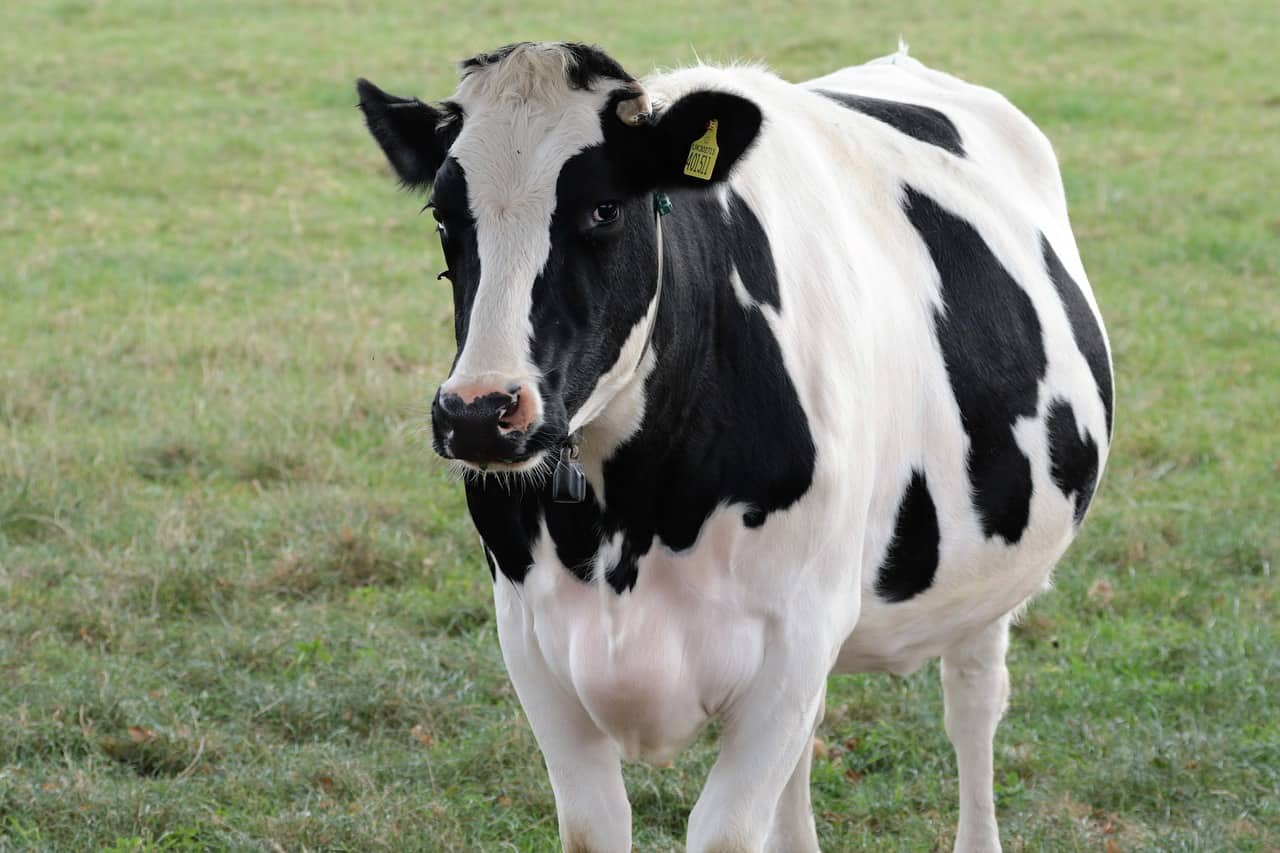
The Holstein Friesian cow is one of the most well-known and beloved cattle. They are often used as mascots for companies that produce milk. In milk production, no one is known better than the black and white cow shown in various media, also known as the Holstein cow. Cartoonists and animators use the Holstein-Friesian cattle in their productions, as they are easy to spot.
The Holstein-Friesian Cattle are native to Northern Holland and Friesland. They are incredibly large compared to other types of cows and bulls. Farmers have been using the cows for dairy for over an estimated 2,000 years. Holstein-Friesians have dominated milk production in the United States. However, they have been noted to have low butterfat content.
Guernsey Cattle

Next on the list of types of cows producing well-known milk, is the Guernsey cow. Breeders and cattle enthusiasts will know that Guernsey cattle produce high-quality milk by consuming grass as early as the 19th century. Since there are no records, it is unclear whether the Guernsey cattle were available past the 19th century.
Guernsey cows accumulate about two gallons of milk per day. If there are calves that no longer drink the cows’ milk, the average increases up to four to five gallons. Content of butterfat found in Guernsey cows’ milk is up to five percent at maximum. The Guernsey cows’ milk is also yellowish because it contains high amounts of beta-carotene.
Watusi Cattle

The Watusi Cattle are considered part of the dairy cattle. However, Watusi cows produce only one gallon of milk each day. The actual use of Watusi cattle is for bragging rights. Compared to other types of dairy cattle, Watusi cattle are used by the Tutsi, Ankole, Kivu, and Bahima nomads. In fact, they can be bartered similarly to other spices, metals, and clothing.
Watusi Cattle have physically intimidating longhorns and small humps at the back of their necks. In America, Watusi is slaughtered for their low-cholesterol and low-fat meat. Despite the differences in culture, both Americans and the nomadic tribes can agree that the Watusi is a valuable source of wealth and income.
Ayrshire Cattle

The Ayrshire cow is similar to the Holstein Friesian except for the color. Most Ayrshire cows have brown spots compared to Holstein cows which have black. Breeders acknowledge that Ayrshire cows have a gorgeous shape and a high-quality udder in terms of dairy production.
Ayrshire cows are known to produce milk that would be used for cheese and butter. Scottish farmers have been using Ayrshire cows for these products for a long time now. Ayrshire cows even have a long period of production. Breeders noticed that Ayrshire cows produce milk 10 years longer compared to the other types of cows in the dairy cattle class.
Jersey Cattle

Jersey cows can produce six gallons of five percent butterfat milk every single day. Interestingly enough, Jersey cows are usually docile. In comparison, the Jersey bulls are some of the most aggressive bulls in the dairy cattle class. Jersey cattle are incredibly adaptive to any environment.
Folks easily confuse the Jersey cattle with the Guernsey cattle. Both have large brown colors, are heavy milk producers, and their milk is yellowish and contains traces of carotene. The difference between the two is that Jersey cattle are smaller and have a singular color of their coat compared to the spots of Guernsey.
Brown Swiss Cattle

Brown Swiss Cattle are the friendliest of all the types of cows and bulls. Breeders and animal lovers are aware of their easygoing and docile nature. Brown Swiss Cattle are used not only for milk production but for their beef, as well.
The average milk production of a Brown Swiss cow in one lactation can reach up to 22,000 lbs of milk. Most of the milk produced by Brown Swiss cows has four percent butterfat and a 3.5 percent total protein content. While most cattle do not exceed five years of life, the Brown Swiss can live up to twenty years. Americans have bred the Brown Swiss Cattle the longest. They are considered one of the oldest of the dairy cattle breed.
Burlina

Just like the Brown Swiss cattle, Burlina cows and bulls are considered dual-purpose cattle. However, they are mainly used in milk production rather than beef. Italians imported them around the Verona, Vicenza, and Treviso provinces. The Burlina has many other names such as the Binda, Boccarda, Bassanese, and Pezzata degli altipiani.
The Burlina is well-known for its resistance to diseases such as tuberculosis. This makes it easier to breed Burlina with quality milk since antibiotics aren’t as needed compared to other dairy cattle. Their milk has been said to have a “grassy taste.” Unfortunately, they are left vulnerable, caused by both World War 1 and World War 2. They were even replaced by Friesian cattle afterward, adding to their further decline by the 1950s.
Icelandic Cattle

The Icelandic Cattle can be traced historically. Nordic settlers brought cows to Iceland in the 9th century, making them the Icelandic cattle ancestors. Researchers have proven that the Icelandic cattle are relatives of the Scandinavian cattle.
The Icelandic government created the Huppa database, which keeps track of all the cattle being recorded. The Icelandic Cattle are also the only known dairy cattle in Iceland. They produce an average of 5,700 liters of milk per year. Produce such as cheese, yogurt, cream, butter, and skyr also come from Icelandic cow milk.
Types of Cows: Beef Cattle
A lot of people are avid fans of meat, specifically cow meat. This is why beef cattle are slaughtered after a year into maturity and turned into different types of beef, such as T-Bone, sirloin, and veal. And despite it being a commonplace in our lives, some are still against killing cows for meat. These people are called vegetarians. In fact, countless groups are advocating to stop eating meat, but the practice still goes on without any signs of stopping. Here are some of the cattle used to make the types of beef we eat in rare, medium rare, medium, medium well, and well-done.
Brahman Cattle

Brahman cows and bulls are popularly known as beef cattle. The Brahman cattle are part of the Bos Indicus, which means they are descendants of Indian cows. They are incredibly popular beef cattle used in Argentina, the United States, Colombia, Paraguay, Brazil, and Australia. The Brahman Cattle are breeds of the Zebu cattle that were exported to the United States from India. They are the result of crossbreeding the Kankrej, Gujarat, Ongole, and Gyr. The Brahman Cattle are the first beef cattle ever created in the United States.
Brahmans are known to be able to withstand extreme heat and live in tropical areas. Their skin is also so thick, they can repel insects and pests. Brahman Cattle also live longer than other types of cows and bulls, and can give birth to calves until the age of fifteen.
Belgian Blue Cattle

The Belgian Blue Cattle are notorious for having the most muscular body in all types of cows and bulls. Specifically, they can weigh up to 1,250 kg. According to PETA, an animal rights organization, Belgian Blue cattle are victims of abuse. Belgian Blues are bred specifically for a mutation called “double muscling.” PETA activists say that Belgian Blues are a result of beef companies trying to find a way to produce more meat.
There is even scientific evidence behind the cruel mutation of Belgian Blue. Breeders will notice that most Belgian Blues require C-section operations when giving birth. Also, they always have joint pain, heart problems, and even bone issues. Because they were crossbred to become the perfect cattle, Belgian Blues have tender and more meat compared to other natural breeds. They’re also less temperamental and may produce quality milk.
Charolais Cattle

Out of the many types of cows and bulls, the Charolais cattle are one of the very few that only come as a white cow or white bull. Originating from France, the darkest color a Charolais cattle would have is wheaten. Great Britain imported the Charolais after a gruesome dispute, and they are raised for their meat. Breeders also crossbreed the Charolais with Angus and Hereford cattle.
Charolais beef is at the top of the list in terms of being a terminal sire. Breeders and zoologists alike have noticed their extreme pace of growth. Their meat products are also of great quality. Farmers are aware that they are perfect for reaching a high finished weight before being turned into beef.
Highland Cattle (Fluffy Cows)

Highland Cattle are popularly known as the “Fluffy Cow Breed”, that became a viral sensation on the Internet with the nickname “emo cow.” People can easily notice their long wavy hair that helps them against the harsh environment of the Scottish Highlands.
Farmers discovered that Highland Cattle can be used as milking cows, but most farmers keep them for their meat, making them predominantly beef cattle breeds. This is because the Highland Cattle’s meat is lean and well-marbled, making it an expensive produce not just for the taste. Nutritionists have tested that Highland beef is low on fat and cholesterol (even lower than chicken.) It also produces high amounts of iron, which is good for anemic folks.
Aberdeen Angus

The Aberdeen Angus is part of the endangered types of cows and bulls. Hugh Watson was a tenant farmer in Angus when he developed and founded the Aberdeen Angus during the 19th century. All Aberdeen Angus cattle come from one stud: Old Jock. Watson’s favorite bull was Old Jock. Coincidentally, Old Jock was even given a statue memorial in Glamis Castle in 2017.
Angus breeds are popularly known as beef cattle. The Aberdeen Angus cows are known to give birth to calves without much difficulty. Mother Aberdeen Angus cows have strong instincts that their calves will inherit. For example, the instinct to stand and suck on their mother’s udder the moment they are born. Although Aberdeen Angus beef usually grades high on USDA scales, it doesn’t necessarily mean that all Aberdeen Angus beef is of a high grade.
Red Angus

The Red Angus is a result of breeding Viking-brought cattle with English and Scottish cattle. These cattle were then bred with the black Celtic cattle of Scotland. Old Jock, the famous ancestor of all Aberdeen Angus cattle, was a Red Angus. Eric Pentecost, on the other hand, is a breeder who believes that the reddish color of the Red Angus comes from English Longhorns, that were crossbred with the breed to make them larger.
Red Angus cattle are classified to be heterosis. This means they have a production advantage when they are crossbred with other species of cattle. They have high-quality beef, which is intramuscular marbling. Additionally, they’re also known to have long lifespans.
Japanese Black

Most people would know the Japanese Black cattle for their other name, wagyu, which is considered the most expensive type of beef. The Japanese used draught cattle originally to plow through rice fields. Wagyu cattle are the result of a mixture of strains from different cattle breeds. The Tajima, Shimane, Okayama, and Tottori cattle are the most dominant strains in creating the Japanese Black cattle.
Wagyu beef is soft with high unsaturated fat content. Their meat texture is considerably finer than other beef. Moreover, wagyu cattle also have the characteristics of a ribeye yield.
Square Meater
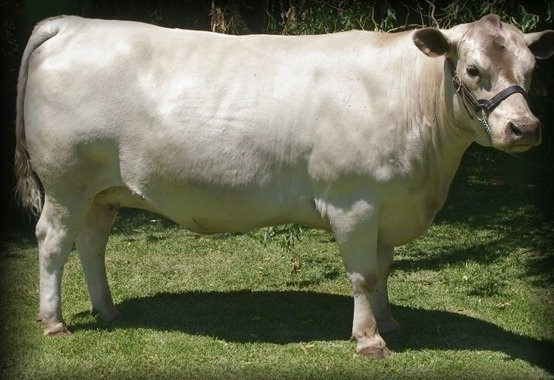
The Square Meater is a relatively new breed compared to the other types of cows and bulls. Rick Pisaturo created the Square Meater in the 1990s to produce more veal to be sold. Pisaturo’s goal was to create a type of cattle that could give a maximum of three hundred kilograms of vealer in nine months since birth. The Square Meater is a result of selective breeding between Murray Grey cows and bulls that prioritize structured muscles and good milking.
Square Meaters are known to mature early. They can also be used to make milk (not as much as dairy cattle), classifying them as dual-purpose. Pisaturo succeeded in his purpose of making the Square Meater. These cattle are used to create small, but premium graded beef.
Belted Galloway (Oreo Cows)

Belted Galloways are the types of cows and bulls that resemble Oreos. People affectionately call them “oreo cows” because of the white line that crosses between their black fur. Belted Galloways are of Scottish descent, and back in the 17th century, they had more than just this specific color pattern. There used to be more patterns and colors a Belted Galloway could have, but breeders decided to selectively breed only the color black by the 19th century.
Belted Galloways are considered dual-purpose. People still prefer to consume them as beef. They can withstand cold temperatures, making them perfect imports in Canada. Belted Galloway cows are known to be excellent mothers, raising their calves well with little complications. Moreover, the meat from the Belted Galloways is well-marbled and low in saturated fat content.
Chianina

The Chianina cattle are the largest cattle breed in the world. While the skin of the Chianina is black for both cows and bulls, their color ranges from dark grey ends to porcelain white. These cattle can withstand high temperatures, and are also resistant to pink eye or eye cancer because of the blackness of their skin. In addition, their muscles make really good marbled beef. Italians use Chianina beef to make traditional Italian beef dishes such as grilled steak in Florence.
Historians suggest that the Chianina cattle may be one of the oldest cattle to have ever existed. This is because of their appearances in Roman sculptures and poetry written by Georgic poets such as Vergil and Columella. Chianina’s name comes from the Chiana Valley in Italy.
Types of Cows: Draught Cattle
Farmers use draught cattle to aid them in agricultural production. They aren’t necessarily used for slaughter, unlike beef cattle, or considered dairy cows. Farmers use draught cattle to plow through the fields and pull carts of heavy items from one place to another. Most of the types of cows and bulls listed here are Bos indicus, referring to Indian Zebu or Brahman cattle. Moreover, most draught cows produce very little milk as well but are sturdier and steady footed. They make for brilliant companions for farmers and can even be ridden by people if trained properly.
Khillari Cattle

The Khillari is an Indian cow like most of the types of cows and bulls in the draught cattle class. Hinduism treats cattle as sacred so Indians prefer using them as help rather than consuming them. If you will look for Khillari cattle, know that their physical appearance is different depending on the location. However, you can still identify the Khillari cattle by their upward horns. Khillari cattle are also one of the few members of cattle that have a spotted cow nose.
People call the Khillari cattle by another name: the Tapi Khillari. Regardless of whether it is a Khillari cow or a Khillari bull, the species should have a large bump on its back. Moreover, the Khillari bull has tighter humps compared to the females.
Umblachery

Umblachery cattle are known for their strength and sturdiness. They are one of the most popular draught cattle breeds. The name Umblachery is taken from the small town the cattle originated from. People also call the Umblachery cattle Molaimadhu, Southern, Mottaimadhu, Tanjore, Therkuthimadhu, and Jathimadhu.
Umblachery calves are typically born with red colors. Umblachery’s color changes to grey as they mature further into adulthood. Farmers usually use the Umblachery cattle for plowing and other farm work, but they can produce milk up to 494 kg per lactation.
Red Sindhi
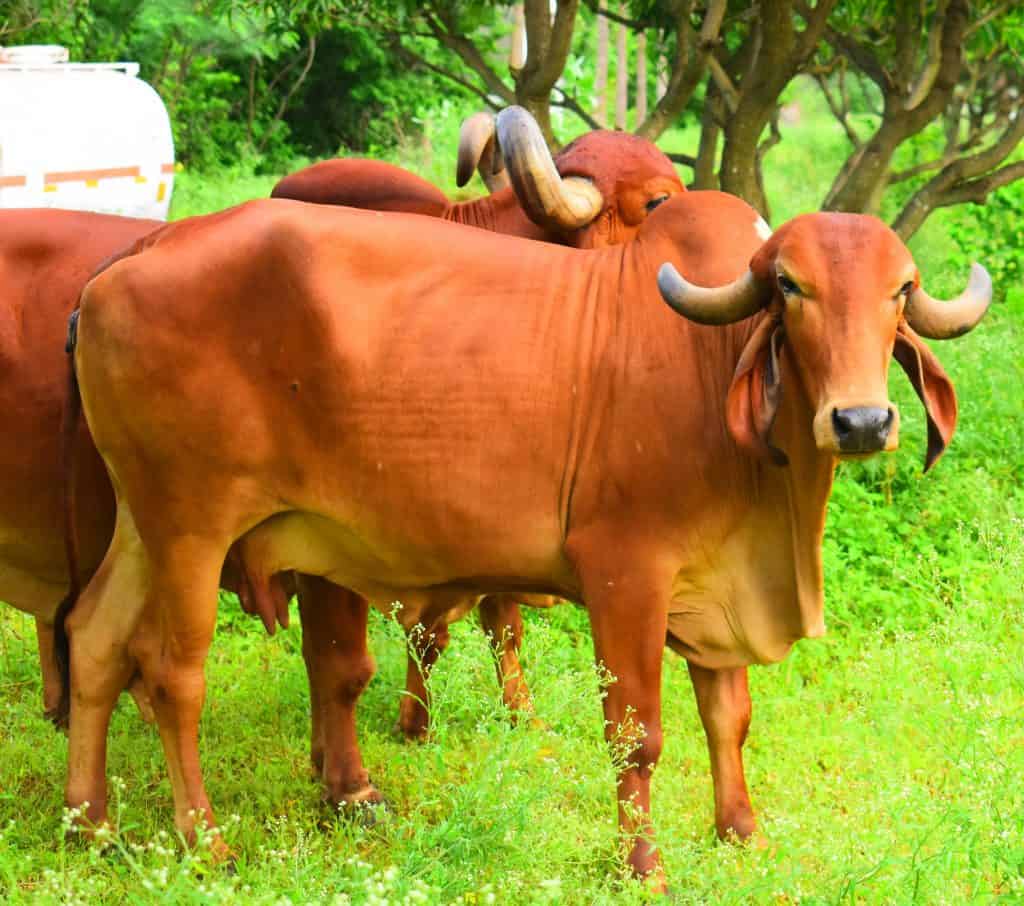
Red Sindhi cattle are native to Pakistan. They are the types of cows and bulls that were traded and spread across different countries. This is because the Red Sindhi is acknowledged to have high heat resistance and produces large quantities of milk. Red Sindhi can be found in over thirty-three countries all over the world.
The Red Sindhi is dual-purpose cattle. While the females are used to produce gallons of milk, the bulls are used as draught cattle. There are even Australian Red Sindhi cattle born and raised in Australia alone.
Bargur Cattle

Locals in Bhavani Taluk of the Erode District in Tamil Nadu would point you to the Bargur hills if you were looking for the Bargur cattle. Bargur cattle are unique for their trotting ability and are excellent help in agriculture. They aren’t typically used for milk but can lactate out 350 kg of milk per lactation.
Bargur cattle are brown with white spots all over their body. Their horns are a lighter shade of brown and grow backward from the head. Breeders prefer to keep Bargur cattle in semi-feral conditions by enclosing them in “pattys.”
Ongole Cattle

Indians take pride in the Ongole cattle. Native to the Andhra region and located in the Prakasam District, the Ongole cattle are named after their place of origin.
Ongole cattle are the most widely distributed and bred internationally. Some people call the Ongole cattle Nellore cattle. The reason for them having another name is because they were also spotted in the Nellore area.
Deoni
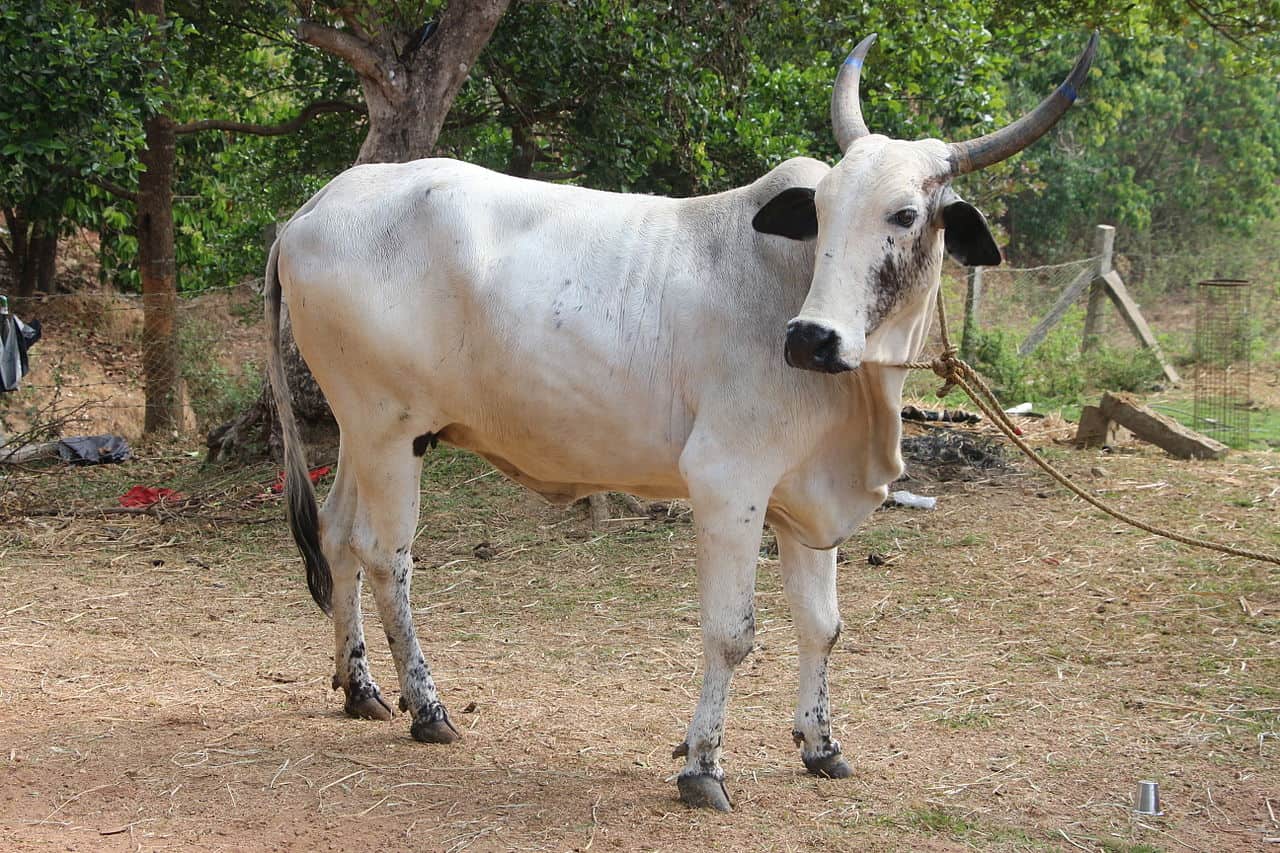
Deoni cattle are beautiful draught cattle that descended from Gir, Dangi, and other local cattle. The name Deoni comes from Deoni talk, a location in the Latur district of Maharashtra. People call Deoni cattle Surti, Dongarpati, Wannera, Balankya, Shevera, Dongri, and Waghyd.
The Deoni is a black and white spotted cattle. Deoni also has small blunt horns that extend from the side of its head. Its ears are also adorably droopy. Most Deoni bulls are used in heavy farm works. They are also effective in heavy labor up to twelve years of age.
Hariana

Here we have another dual-purpose breed in the form of the Hariana cattle. They are native to the Indo-Gangetic plain. Hariana was once called Hisar and Hansi (based on the names of their place of origin).
The average Hariana is white or light grey. They have long narrow faces and small horns. Hariana cattle may be dual purpose, but they are mainly used as draught cattle. However, they also produce large quantities of milk. The quality bred Hariana cows can create 1,700 kg of milk during each lactation.
Gaolao

The Western and middle part of India is where the Gaolao freely runs. Arvi and Gaulgani are other names the Gaolao are called. They have similar features as the Ongole cattle, with the difference of them being lighter.
Gaolao cattle are known to be agile. They are perfect for transporting wares and even people up hilly areas. The Gaolao bulls are trained to move fast, while the Gaolao cows are cared for regardless of their low milk yield.
Mewati

The Mewati cattle are known as Kosi and Mehwati. Breeders raise them to be used as draught classes. Mewati cattle are known to be as powerful as they are docile. They are excellent in heavy plowing, drawing water from the deepest of wells, and even carting.
Mewati cattle are dominantly similar to Hariana, Gir, Kankrej, and Malvi breeds. Patterns of the Mewati are usually pure white except for their neck and shoulders, which are quarters of a different shade.
Hallikar
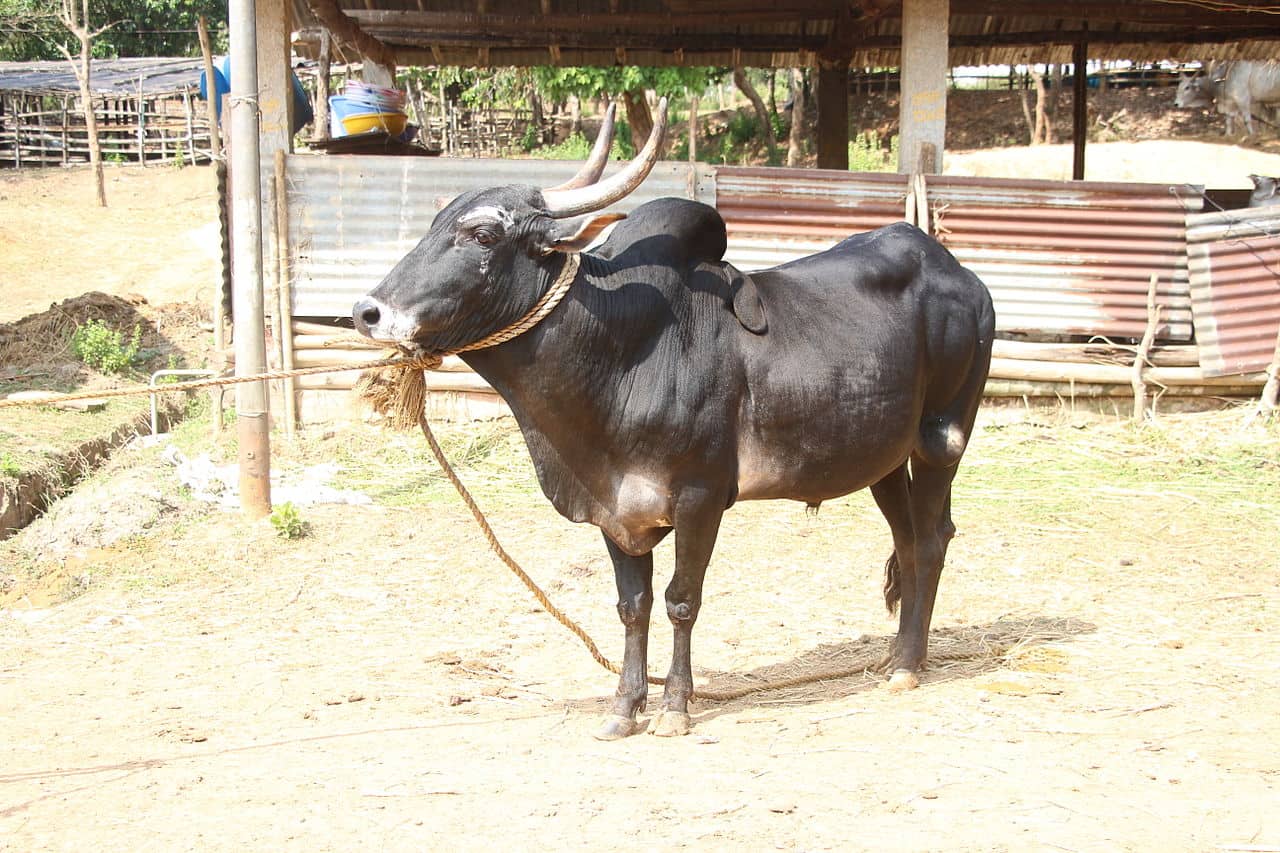
Last on the list of types of cows and bulls is the Hallikar. These draught cattle originated in Karnataka, India. The People of Hallikar are known to traditionally rear cattle, including the Hallikar cattle breed. There are notable differences between the female and males of the Hallikar cattle. An example would be that the Hallikar bull has a more defined hump on its back compared to the Hallikar cow.
Hallikar is one of the few two breeds to receive royal patronage and care of the Maharajas of Mysore State. Coincidentally, the Amrit Mahal (the other breed to receive this protection) is theorized to be descendants of the Hallikar cattle.
Conclusion
We hope you enjoyed this list of the types of cows and bulls. Whether you came here trying to learn or are just plain curious when it comes to facts about cows, different cattle breeds, or for any other reason, discovering more of these wonderful beasts are surely worth it. Although there’s no shortage of them, it’s still important to appreciate them and protect them from animal abuse, such as bullfighting. Which one was your favorite from all the types of cows and bulls?
Was this page helpful?
Our commitment to delivering trustworthy and engaging content is at the heart of what we do. Each fact on our site is contributed by real users like you, bringing a wealth of diverse insights and information. To ensure the highest standards of accuracy and reliability, our dedicated editors meticulously review each submission. This process guarantees that the facts we share are not only fascinating but also credible. Trust in our commitment to quality and authenticity as you explore and learn with us.
